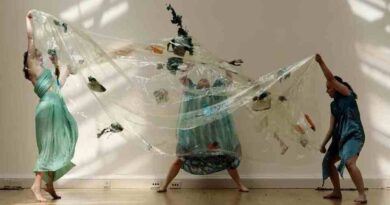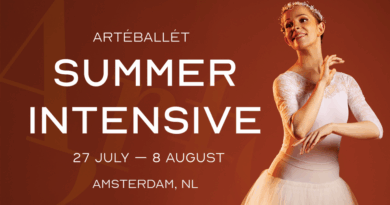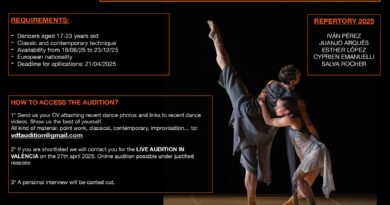
Save their souls: The importance of dance and the arts for young people
In response to the decline of the arts in schools it has been said that the drop is due to the increase of IT and computing. If you’re wondering how this could possibly be justifiable, John Nash, Parliamentary Under Secretary of State for the School System in the UK, offers this:
“I think we all know that the quality of some of these subjects was not what it might be, and that quite a few people were taking [the arts] not because they suited them, but because they were easier.”
Statements like these must be challenged. Firstly, having trained for a degree at a performing arts college, the ‘easier’ remark is what infuriates me the most. In no way do I mean to undermine university degrees, but my contemporaries’ accounts of 8 hours of class a week pale in comparison to my 8 hour DAYS. Days which were extremely demanding both physically and mentally. The term ‘easy’ never crossed my mind in the whole three years I spent at college. Having said that, Lord Nash’s remark was based on the subject of GCSEs (General Certificate of Secondary Education in England and Wales) and to compare this to a degree level of study would be misleading. However, how often has the reply to hearing you studied an arts subject at any level been anything more profound than, ‘Oh, I bet you had fun!’
There is the crux of the debate: fun. Why shouldn’t you have fun studying a subject you enjoy? Because it can’t lead to a job in the corporate world, or to a role in medicine, saving lives? Some people call working in the arts ‘selfish work’, drawing parallels with psychological egoism, “the view that humans are always motivated by self-interest”. However, it could be argued that psychological egoism applies to roles in medicine even more so than dance in that “it claims, when people choose to help others, they do so ultimately because of the personal benefits that they themselves expect to obtain, directly or indirectly, from doing so.” For personal benefit or not, doctors save lives, dancers save souls. I am talking especially about young souls, and lives for that matter. Dance is often shunned as a curriculum subject, and is increasingly cast into the extra-curriculum pile. But what could be more enriching and promote both physical and mental health, than dance? Not maths I can tell you.
The uptake of GCSE arts subjects is in decline. It cannot be ‘made up for’ by an increase in IT and computing, or with anything else for that matter. Arts subjects are unique in their demand for imagination, creation and freedom of expression. Students of dance and the performing arts in particular build a certain resilience in their character to be able to put themselves out there and perform. “The excitement in the air after a performance makes you realize how magical it is for these children” – Madelaine Price, Chance to Dance Programme. Performing creates a buzz and it brings people together, as Kenta Kura (soloist with Royal Ballet) says of the Chance to Dance Programme, “It is real teamwork in the rehearsals and amazing how it has progressed in just the two rehearsals we have had together.”
The truth is these programmes like Chance to Dance (The Royal Opera House’s introduction to ballet program for 24 schools in London) are hard to come by and are often inaccessible to a lot of children, particularly those from disadvantaged backgrounds. There is definitely a need for more dance programmes that integrate with schools and are offered as part of the curriculum. Cate Canniffe, Director of Dance for Arts Council England, says, “Many children and young people rely on in-school provision for their access to dance. Still, there continue to be challenges around schools’ capacity to offer dance as part of the school day and the value placed on dance and the arts more generally within the curriculum.” In a review in The Stage, it was revealed that “one in 10 teachers responding to a Guardian survey claim art, music or drama has been dropped from their schools due to funding cuts.” Quantity of arts subjects is clearly a problem but what about the quality too? YDE School Dance Coordinators found in a previous audit that “10% of teachers teaching dance in school have a degree in dance and qualified teacher status”. That is not enough. Nowhere near. It is not encouraging or inspiring for children to learn dance from a teacher who lacks experience, let alone one who is simply not aware of safe dance practice. Not to mention the other side of the argument; the fact that so many qualified dancers are unemployed and seeking work. It is a heavily saturated industry and if the school system cared more about these roles then it could improve the situation twofold: put dancers in work whilst inspiring school children with competent dance lessons.
Dance and the arts are not ‘extra’ or ‘add-ons’, they are fundamental to learning and to our society. As Laura Field puts it, do we think that “our billions of pounds of exports in film, TV, online gaming, design, art and music are some happy accident”? If we are not educating enough young people in the arts, how can we expect to sustain our output and revenue in the industry? The fact that theatre ticket sales are up 25% in London in the last 15 years, not only proves a huge economic benefit but it also highlights the demand on the arts sector.
The UK’s National Young Dance Ambassador Chris wants “dance to be known for what it does – it brings together the whole body with the mind and personality to express ideas & increase fitness. It is musical, physical, diverse, social and competitive. . . It does everything!” It does indeed. As One Dance UK (the lead dance industry body in the UK) explains, “Dance breaks down social and cultural barriers and improves communications between individuals and groups. Because it plays a vital role in helping young people achieve and sustain physical well-being, dance can help tackle issues of obesity and other health problems. It has particular appeal to people who may not readily engage with traditional sports, such as young women and some cultural/ethnic groups.” This last point carries such importance and there is plenty of evidence to back it up. Statistics from Sport England in their 2014-2015 review state that “40.6% of men play sport at least once a week, compared to 30.7% of women” but that “nearly 500,000 females participate in ‘exercise, movement and dance’ once a week compared with 0 male participants”. Data from the Child Taking Part Survey shows that” girls are more likely than boys to engage with the arts at both primary and secondary school age”. In a study by Bridgewood et al in 2003 focusing on arts engagement within ethnic groups, they found that more Indian women than Indian men attended at least one arts event in the same period.
In short, we need dance. We need dance to reach young people. Otherwise what will we be left with? Dance and the arts cannot be allowed to fade into the background. It is simply not in its nature; it needs the spotlight. So in this booming technological age, let’s direct that spotlight back to where it belongs and use these exciting technical advances to create wonder and spectacle. I’d rather that than lose my job as an administrator because AI has been developed to do it better and faster. Who’s with me?
—
Photo: © All rights reserved by marnieannjoyce
- Anorexia and Dance. Looking for the perfect body in dance! - July 6, 2019
- Save their souls: The importance of dance and the arts for young people - July 4, 2019
- In the in-between…how to survive between dance contracts - July 3, 2019



